Barcelona, Spain has long been seen as a wheelchair friendly travel destination. So how wheelchair and scooter friendly is Barcelona? The answer is that there is more good than bad.
Streets and Sidewalks
On the plus side are the chair friendly street surfaces which in general are well maintained and by and large flat in the main tourist areas. An exception is Passeig de Gracia, (a main street that’s very clean and well maintained with some of the higher end of the market shops, tapas bars and hotels), which has a noticeable gradient although one that is not challenging to the majority of wheelchair users.All street corners have kerbs with ramps to road level making life pretty comfortable for crossing roads, not all however are to European Union standards so gradients vary (even though most ramps are pre-fabricated, poor installation can alter the angle and height considerably, and does!) although few wheelchair users will be challenged overly by these minor irritations.
One area that can be an issue for manual wheelchair users is that Barcelona doesn’t experience high levels of rainfall, this means that street surfaces become greasy and very slippery when the rain does fall, some surfaces provide a ‘skating rink’ experience at times making walking a dangerous occupation and wheel traction difficult. Power chairs and scooters by virtue of their weight tend to have fewer if any of these problems. An issue for all though is that many Barcelona hotels have beautiful entrances and foyers surfaced in marble, unfortunately in all too many cases there are no wheel grabs on the entrance ramps so its a major challenge getting into the hotel on a rainy day with the marble drenched in water!
Transportation
Public Transportation is a big plus as all buses are accessible with ramps, the downside is that many ramps don’t work properly, or the driver parks the bus in such a way as to make it impossible for the ramp to be deployed, or there are obstacles preventing the use of the ramp (a frequent occurrence) such as cars badly parked, trees growing in inconvenient spots (OK so the bus stop can be moved but….!) and communal rubbish containers left too near to the bus stop. Once inside a bus its comfortable and there are safety belts fitted as standard, low level buttons to request a stop and on some of the newer buses the call request button also has Braille inscribed.
The tram system is comfortable and 100% wheelchair friendly as are many of the metro lines. The downside with the metro system is that not all stations on a line may have lifts so you may find yourself travelling along to a different station before you can get back to street level, don’t be fooled by the metro map showing ‘accessible’ stations as not all are (my own local station is listed as wheelchair accessible however has turnstiles still and the electric gate option for wheelchair access or child buggy access is rarely working and as the station is not manned, (most stations are now free of staff, lots of lovely ticket machines though) there’s no way to pass to the platform. Also where you can access the platform many stations do not have ramps to the level of the trains. Metro trains are clean, modern and fitted with wheelchair safety belts in wheelchair designated areas. Weekdays they can run as frequently as every three minutes so there’s never a need to rush to beat the train door closing. Weekends the frequency drops to around every six minutes so still a great service.
The transport system in Barcelona is an integrated one so the purchase of a single T10 ticket for less than 8 Euros (at the time of writing) allows you to travel on 10 journeys hopping from one form of transport to another without extra cost if you continue travel in the same direction and are within a one hour fifteen minute time period from the first time your ticket went through a ticket machine, all in all a great and cheap deal! In many stations there are automated ticket vending machines that have been designed with wheelchair users in mind, with the touch screen common to all the machines at an easy to reach height.
Hotels
Restaurants, Cafés and Bars
Eating out in Barcelona is a journey of delights with a fabulous diversity of Catalan, Basque and Spanish dishes available in the plethora of cafés, bars and restaurants that exist in the city, not forgetting more standard favourites such as McDonald’s, KFC and Starbucks. Look in particular for the pintxa tapas bars, easily recognizable as each food morsel has a cocktail stick stuck through the middle of it. Grab a plate and help yourself from the bar counter and your bill is based on the number of cocktail sticks you have when finished eating, expect to pay around €1,60 per stick.
Favoured Catalan tapas include Patata Bravas (deep fried potatoes served with a spicy sauce); pan con tomate (baguette slices covered with the juice of tomatoes and olive oil) and Jamon Iberico (sliced cured ham, simply divine in most eateries, expect to pay around €16 for a plate), not forgetting of course a wide range of olives.To accompany these culinary delights you might want to try locally produced Torres wines (Torres regularly win gold medals in world tasting events for the quality of their wines and brandies), a personal favourite of mine is a crisp white called Esmeralda costing around €6 a bottle. Sodas such as Coke cost more than beers, wines and coffees as do bottles of water and fruit juice in many cafés Pintxa tapas so you have a small incentive to enjoy locally produced beers, wines and spirits.If you are on a budget then look for ‘menu del dia’ signs. You will be served with three courses for around €10 to €15 including drinks (soft drinks, wine/beer or coffee) from a selection of 3 or four dish options usually for each of the three courses, great value for money always.
If like me you cannot drink alcohol for medical reasons you will find alcohol free beer is freely available in all bars, etc. A downside to eating outside of your hotel is that few local bars and cafés have wheelchair user friendly toilets, in those that do its usually the ladies toilets fitted out with side grab bars and not much more, wash facilities tend to remain standard and difficult in many instances to access from a wheelchair. Sinks tend to have taps that require the top to be pushed inwards for water to come out and these often require quite a bit of force, almost impossible to use if you have arthritic hands or limited arm and hand movement. Exceptions are in shopping centres such as Glories and Diagonal Mar where infra-red taps are used.
When in doubt go to McDonald’s, plenty of them in the centre of Barcelona and all with accessible toilets fitted out correctly and with wide door access.I also suggest when the urge comes upon you and there’s no McDonald’s in sight to pop into the nearest El Cortes Ingles department store which have excellent facilities. If you are near the Cathedral most of the bars in the square opposite it have accessible toilets. Note that following fairly recent changes to legislation that all eating and drinking establishments are no smoking zones, if you get the urge for a nicotine buzz outside you go!
Currency Exchange, ATMs, Pick-Pocketing and Other Money Tips
At some point the changing of money into Euros or drawing money from a ‘hole in the wall’ facility will need to be done. Simple rules to remember, money exchange booths cost the earth, banks charge high commission rates but they are fixed so are expensive for changing a small amount but cheap for large amounts relatively speaking. Hole in the wall options are the cheapest of all but withdrawal rates do vary, I find that the Caixa Catalunya provides decent rates and also banks with the ServiRed symbol are OK.A word of caution for USA visitors, I have come across some bank cards issued by American banks that DO NOT WORK in hole in the wall machines in Barcelona so check before leaving home that you have cards that will work in a European country, also note that machines have withdrawal limits PER transaction so even if you have prearranged limits with your bank these may mean nothing when using a Spanish machine.
A little trick to try is to withdraw the maximum possible, usually 300 Euros and then go through the transaction process a second time to reach the sum you require, it usually works so you can obtain larger amounts than permitted from one withdrawal.Two more points briefly, American Express is not generally accepted in Barcelona, where it is you may find a surcharge added to your invoice, secondly for all transactions with a card of any kind identification with photograph such as a passport will be required, without exception! Finally be aware that hole in the wall machines designed to be accessed from a wheelchair don’t exist in Barcelona.Pick-pocketing remains endemic in tourist areas.
La Rambla, for one, requires extra special care and vigilance where personal belongings are concerned. Wheelchair or scooter users are seen as easy targets with bags hung over handles or kept loosely on a lap, cameras naturally make very tempting targets, as do MP4s. Balancing the negative is that the number of plain clothes police on duty has risen to high levels and detection and arrests have increased accordingly, unfortunately this doesn’t stop the bad element of society continuing to try their luck at your expense. Should you suffer a theft you’ll need to visit the Mosses d’Esquadra police station situated below Plaça Catalunya in the centre of town. Forget talking to any other kind of police officer such as the Guardia Urbana, Guardia Civil or Policia Nacional as street theft has nothing to do with them and they’re quick to let you know so!
About Sightseeing and Attractions
Now you have some cash in your pocket you want to spend it on the cultural delights of Barcelona after all it’s why you’re in the City! In simple terms the city is divided into two distinct parts, the Gothic and Roman heart of the city and the more modern example area arguably dominated by La Sagrada Familia. In reality there’s more to the area but this topic needs to be left to another day for more detailed explanations. When mapping out how to visit sites it’s worth noting the geographical make-up of the city and the order visits should be made in. For instance, visits to Gaudi Buildings and Park Güell can be done the same day.
Trips to Montjüic to see the Olympic areas, botanical gardens, experience the cable cars, visit Fundacion Joan Miro, Poble Espanyol need to be done on another day as they are on the exact opposite side; the Roman and Gothic areas also need to be left to a single day to do them justice (combining some elements of Gaudi with Roman and Gothic can be done during a single day, this option will require much energy on your part as it makes for a long and tiring day!). Trying to mix the areas in one morning for instance requires transport and will find you sitting frustrated in the inevitable traffic delays when trying to cross the city by public transport or in a taxi to see the site of your choice (using the metro doesn’t improve options either, you just don’t see cars!). Mapping out the areas as I’ve noted saves time, frustration and provides more time to enjoy the experience and ambience of a site.
La Rambla is actually three streets joined in a single line each clearly named as you pass along the street and defined by the parochial church district in which they lie, namely Rambla Canaletes, Rambla St Josep and finally Rambla Caputxins. The three ‘ramblas’ are now joined in one hence the street is defined in the singular La Rambla.At this juncture note very carefully that Rambla Canaletes is the traditional meeting point for supporters of Barcelona Football Club. If ‘Barça’ win the league or some other competition or simply beat arch rival Real Madrid there will typically be tens of thousands on the streets and every celebration ends in civil disturbances between various undesirables amongst the true supporters and the police force, unfortunately these disturbances are usually extremely violent. So its worth checking your vacation dates against the football calendar and booking a hotel that is not on La Rambla for any dates that coincide with games featuring Barça v Real Madrid (home and away games), Champions League games and Copa del Rey. La Rambla has undergone many changes recently with the much detested booths selling live animals that were kept in terrible conditions having been replaced by other more acceptable business activities.
Due to other government regulations on artists and other vendors, tourist will not find such people common in the La Rambla area. Crowds are an issue to be aware of too in this area along with pick-pocketing.Two areas worth mentioning that run off La Rambla are the Boqueria Market and Plaça Reial. The Boqueria is a fascinating place to visit and well worth the hassle of maneuvering a wheelchair along the narrow aisles (people are very polite in the market and will accommodate a wheelchair users needs) to see all manner of fruits, vegetables, fish and spices many of which may be new to you. One interesting stall sells ‘bugs’ and offers such delights as fried scorpion! Plaça Reial is well worth visiting if only to see the public lamp standards designed by a young Antoni Gaudi. On most Sunday mornings the Plaça is filled with collectors of all kinds of collectibles from stamps to bottle tops (caps from Cava bottles are very collectable), all busy seeking that all important item missing from their collection.
There’s a wide range of cafés and restaurants to visit offering pretty standard food and prices, none have accessible toilet facilities. Moving into the Roman and Gothic areas the most dominant feature is the Cathedral which was started in 1298 and has been undergoing extensive renovation to its exterior in recent years. Pretty disgracefully access to the Cathedral is not a simple business as the main entrance is all steps and the popular cloister entrance also has steps. No ramp access exists as a fixture at either entrance although at times a wooden ramp is available to be deployed at the cloisters however in my experience staff are less than accommodating in assisting wheelchair users.
The only ramped access is in Plaça St Iu, however, the door is locked and someone has to inform Cathedral security staff that you want to get in which means you can have a pretty long wait before someone decides to let you in! In this Plaça is an excellent Museum, Frederic Mares and there is access for wheelchairs with one tiny problem. To first enter the Museum courtyard there’s a wheelchair lift that requires a key to operate it. To get the key you have to telephone the number detailed on the lift so if you want to visit the museum make sure that a) you have brushed up on your Spanish and Catalan and b) that you have a cell phone with you!Moving on the next feature is Plaça del Rei with the Royal Palace, Iglesia de Santa Agata and thePalau de Lloctinet (which has a short but steep concrete ramp to enter but is well worth the effort to tackle as the interior of the Palau is spectacular). Its a wonderful Plaça and if you are lucky and have avoided the massive cruise groups and school groups you will have a tranquil viewing accompanied possibly by one of the professional street musicians strumming a classical guitar, cello or even a former international concert pianist performing the ‘classics’ on an electric piano.In this part of Barcelona there’s no real obstacle to wheeling the streets, the drawbacks only being trying not to get lost in the warren of tiny streets and touring with the knowledge that accessible toilets are not available for comfort breaks.
No visit to the Old City area is complete without seeing Santa Maria del Mar just off Carrer Argenteria. This Gothic church has a very special ambience and some stained glass windows that are mesmerizing. Ramped access is available without the restrictions experienced at the Cathedral via a side entrance easily located. After a visit its a short stroll from the church to the Picasso Museum, Carrer Montcada, which as with the vast majority of museums in Barcelona has been adapted for wheelchair access, do note at this point that all museums in Barcelona are closed onMondays.It is also worth mentioning at this juncture that many museums allow free entry for wheelchair users and that queuing is not necessary as wheelchair users get priority entry along with one companion.If Picasso is not to your taste then the Museum of Chocolate surely is! Situated a stones throw away from the Picasso Museum in Plaça Pons i Clerch, this museum has a fascinating display of all things related to the cultivation and processing of beans to finished product. The life-size chocolate sculptures on display are quite amazing, ideal for a rainy day and for keeping the children occupied.
For a stroll in ‘aire libre’ venture a little beyond Carrer Princesa (circa both museums mentioned before) and cross to Parc de Ciutadella where the Barcelona Zoo is situated, also near is the Arc de Triomf. This park has been developed to provide access including a number of wheelchair accessible toilets located alongside park cafés. This a delightful place to pass a Sunday afternoon and there’s sure to be free entertainment to hand as jugglers practice their art, guitarists strumming and a myriad of other activities take place.To one side of the park is a tram station. The ‘tramvia’ service uses ultra modern trams which have designated wheelchair areas fitted with safety belts and the service runs from Ciutadella to the Forum (actually the route extends a little beyond the Forum however not to places of interest to visitors).
At the Forum a major shopping mall is to be found, Diagonal Mar which has a fabulous range of restaurants on the top floor, checkout Sagardi for top quality tapas all in one price buffet featuring other tasty morsels imported Argentinian beef cooked in front of your eyes to your requirements.Running from the Forum back towards the city is the beach, recently renovated to the standards developed for the 1992 Olympics. The beach is divided into fairly distinct elements from family to nudist with wheelchair access down to the sea available via wooden ramps at regular intervals along the length of the beach. During the summer months its also possible to use wheelchair immersible tricycles which can enter the first few metres or so of the seashore. Few of the chalet type restaurants along the beach have accessible toilet facilities however at Port Olympico where the Casino is situated there’s a nice range of cafés and restaurants most with suitable facilities for wheelchair users. Now if strolling along a beach promenade is attractive the walk from the Forum can take you all the way to Barceloneta, the popular family beach and easiest to reach from the centre of Barcelona. Its a nice thirty to forty minutes stroll and a very popular activity on Sundays for the local populace before sitting down for family lunch.
It goes without saying that a little shopping is always in order so a few words of caution to begin with concerning shopping on La Rambla. Many of the shops contain the same variety of tourist products for sale however do not display prices, its up to the visitor to ask for a price and then haggle for an end price, pay what you think some-thing’s worth, if one shop doesn’t match your price another one may! For gifts of Majorica jewellery stay away from La Rambla as there are outlets offering the same items at much cheaper prices on Baixada Llibreteria near Plaça del Rei and on Carrer de Tapaneria which runs off Plaça Nova (Plaça in front of the Cathedral).
In the ‘old’ part of Barcelona the main shopping street is Avenida Portal de l’Angel. Now this area has fairly new shops featuring all the latest in fashion which haven’t in many cases conformed to EU building regulations requiring access to be made available to the disabled when carrying out modifications and shop fitting work. Now I have to say that in some cases there’s only tiny ‘lips’ to overcome to enter some shops but the fact remains they shouldn’t be there at all. The largest store is El Cortes Ingles (very disabled friendly), one of two very close to each other (the second is in Plaça Catalunya). This department store chain is the largest in Spain and has tremendous buying power so unusually for a department store chain prices for all types of goods are basically the same as high street shops, not more pricey as one might expect from a chain such as this. The only expensive element offered by El Cortes Ingles stores are restaurant prices which are pretty steep, at least they have wheelchair friendly toilets (you do have to go begging for a key at the nearest till to the toilets, a small price to pay for what are normally spotlessly clean facilities). For expensive purchases where you’re looking for Tax Back opportunities then El Cortes Ingles is the place for you.
For the more upmarket offerings of Gucci, Chanel, etc and ‘designer’ tapas a trip uphill from El Cortes Ingles in Plaça Catalunya along Passeig de Gracia is required. If you have young children check out Imaginarium which even has a children’s special entrance, also you’ll find a Torres wine outlet which is pretty fantastic. Now Passeig de Gracia is not called the ‘street of books’ for nothing (it even features a large statue of a book, surely unique in the world) as there are some great book shops to browse in and you are recommended to purchase guide books etc. in these shops rather than at tourist sites where prices are always higher. One distinct pleasure of walking along this street is the wide variety of modernist buildings to see and admire including Casa Batllò and Casa Milla (La Pedrera) both Gaudi architecture. If you wish to visit either of these buildings avoid the queues and go to visit late afternoon when the crowds have by and large gone, you’ll have more time to enjoy what’s on offer! A personal favourite of mine is Casa Amatller which was the home of the Amatller family, makers of delicious chocolate which can still be bought today (converted into a museum there are plans to install a lift to make this property accessible for wheelchair users). There are restrictions on areas that can be visited by wheelchair and scooter users will have access problems at Casa Batllò. Unlike premises on Portal de l’Angel the majority of shops on Passeig de Gracia are easy to access in a wheelchair, scooter users will have problems with entering shops as security staff (present in most outlets) are more than likely to stop you from going much further than the entrance doorway.
A brief word about visiting Gaudi sites. One of my favourites is Parc Güell, with the magnificent views from its terraces across Barcelona to the viaducts and of course not forgetting the amazing houses. Unfortunately, for reasons related to its World Heritage status, the Parc has not been made accessible. Now personally I don’t see what the problem is as new picnic areas have been created which are only accessible by newly created steep and irregular steps thus changing the former character of the Parc. It doesn’t take too much thought to creating and placing ramps in crucial access points that can be non-permanent and therefore make no impact to original structures but it seems beyond the administration to do this. It is possible however to enjoy some aspects of this wondrous place, if entering by the upper entrance you can wheel along the Rosary Path and have views of the main Plaça with its serpantine benches, enjoy a drink at the terrace café (expensive) and take in the panoramic views. From the Rosemary path there’s a long twisty paved road that can be taken to the lower level where the ‘gingerbread’ houses are situated. Disabled toilet facilities are available, not the most salubrious in the world but when Mother Nature calls, she calls! From the lower level you’ll be able to view from a distance the market hall and dragon sculpture. Do note that this visit really has to be done top to bottom as described as the road joining the top and bottom levels is STEEP and not for pushing or wheeling uphill. This applies really to all types of wheelchairs and scooters. Also note that public transport is not an option to visit the Parc, the City Tour Bus does not stop next to the Parc, rather it drops you off at the bottom of the hill where Parc Güell is situated, and I have to say that to ascend this hill is not for the faint hearted, disabled or not! If it is raining forget about going to the Parc altogether.
From Parc Güell its only a short drive to La Sagrada Familia which needs little saying about it except its awesome. I fully recommend you visit Bar Gaudi situated where Carrer Valencia crosses Carrer de la Marina. It has a wheelchair accessible toilet (ladies room) at the very rear of the café, usually has no other tourists, the tapas is excellent and better still its cheap. This super little café is only a few minutes away from La Sagrada Familia walking downhill on C, de la Marina in the direction of the sea yet is missed as tourists flock to over priced ‘eateries’ right next to La Sagrada Familia. A word to the wise, don’t be tempted to buy souvenirs in any shop other than the La Sagrada Familia official one, as you’ll pay way over the odds in these shops for items that can be bought in the centre of town or from the official shop on site. Do note that these tourist souvenir shops have to cover the 15 to 20% commission they pay to tour guides to bring in coach loads of cruise sightseers and you’re the one covering that cost!
Additional Information
The final item I’d like to mention is the availability of information about disabled friendly sites to visit in and around Barcelona. The natural and sensible thing to do is to go and visit the tourist information office on arrival so you can plan your visits one by one. Well I have to say that this is easier said than done as neither of the two tourist information offices (Plaça Catalunya and Plaça Sant Jaume) are wheelchair accessible. Now the purist may contradict this statement as the office in Plaça Catalunya has a stair lift however this is always at the bottom of a long flight of stairs, there is no call button and the apparatus is suffering from a severe case of rust so you can draw your own

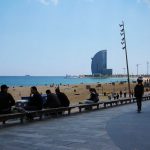
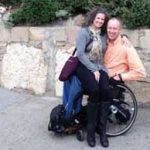

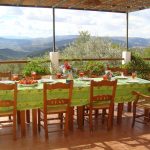
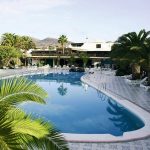
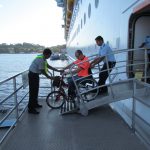



I have just got back from Barca and travelled in wheelchair from BCN airport to the city with http://www.barcelonaairporttaxis.com